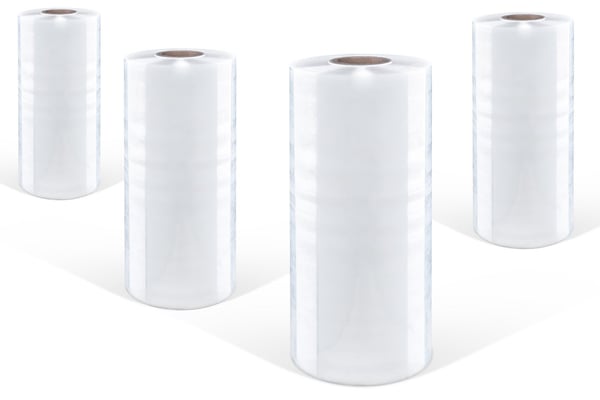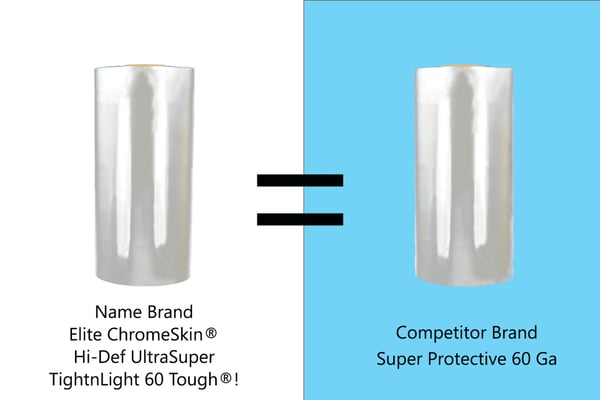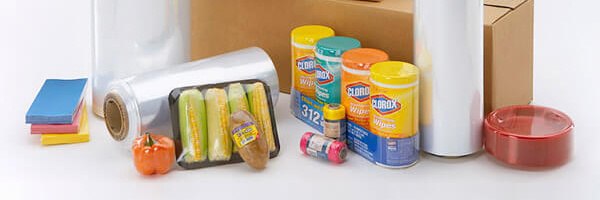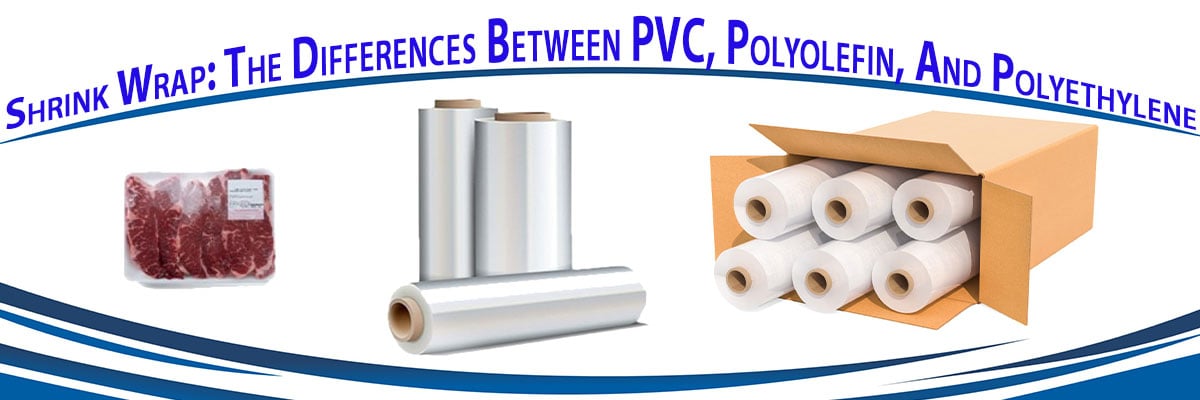Shrink Wrap: The Differences Between PVC, Polyolefin, And Polyethylene
The three main wraps used in shrink packaging material for protecting and securing products for the retail and shipping environments are polyvinyl chloride (PVC), polyethylene (PE), and polyolefin (POF). Each has different capabilities and characteristics that make them suitable for specific applications.
What are the main differences between these types of shrink wrap? Which is the best choice for your packaging needs? Read on to find out!
What is Shrink Wrap Material?
The material known as shrink wrap is a clear plastic wrap that is used to package millions of products around the world. Shrink wrap is called shrink wrap because it shrinks around the product being packaged when it is exposed to heat.
Each of these three wraps can be co-extruded into multilayer wraps with different additives offering specific barrier properties required for shelf-life or appearance. Shrink wraps can be formed into flattened roll stock, bags, overwrap, banding, and tubing, and add a form of tamper-resistant protection to packaged goods. If you aren't sure that you are using the ideal wrap for your application, here's a breakdown of the three:

PVC Shrink Wrap
Once the most commonly-used shrink packaging material in the world due to its lightweight and inexpensive multi-purpose capabilities, PVC Shrink wrap has since taken a backseat to PE and POF for many reasons. Most specifically due to the dangers in health during creation and incineration, and sustainability.
In its rigid form, PVC is durable and is used in many applications, including construction projects and houseware products. In terms of packaging, PVC is seen in rigid applications including blister and clamshell packaging, & flexible applications including shrink wrap, bagging. Polyvinyl chloride is a combination of three elements, carbon, hydrogen, and chlorine.
It is recommended for use in well-ventilated facilities due to the strong, harmful odors that are released when heated. Due to its chemical composition and these harmful byproducts released during its creation, and decomposition for that matter, PVC has been banned in many countries.
Brands that hold high regard for corporate & social responsibility have been joining these countries in banning PVC in packaging. This is important to consider if you have toyed with the idea of using it in your packaging, and more so if you already are using it. The Walmart Sustainability Playbook specifically targets PVC reduction in packaging materials for the manufacturers of products sold in their stores.
Need Help Choosing The Right Shrink? Check out our complete guide to Shrink Film!
Fast Facts About PVC Shrink Wrap:
- Once the most commonly used shrink wrapping material in the world
- Temperamental with hot and cold temperature changes, causing brittleness when too cold and wrinkling when too warm
- Higher resistance to propagation of tear, Polyolefin- higher resistance to puncture
- If you utilize a PVC wrap, it's important to ensure the highest possible standards for use and disposal are used across your supply chain
- Applications for PVC Shrink wrap include: packaging of CD's/DVD's, boxes for gaming & software, and other non-edible items
- Not good for bundling multiple items together due to its more brittle nature after shrinking
- Leaves carbon deposits on sealer, proper and regular maintenance required for consistent operation
- Releases harmful odors during sealing and heating, caution and proper ventilation are a must
- Offers preferential orientation (shrinks in only one direction) and low shrink force
- #3 Recyclable material (certain conditions apply)

POF Shrink Wrap
Polyolefin shrink is an extremely durable and versatile 'premium' shrink wrap. It has taken the place of PVC mentioned above in many applications and is also an FDA-approved food-safe material. Polyolefin materials are available with different characteristics, including cross-linked wrap that provides high-tensile strength and incredible clarity for high-speed packaging applications. The cross-linked wrap also prevents buildup on sealing components of your packaging machinery.
With added strength, the ability to create longer rolls of wrap with thinner gauges available allows for less roll change-over and increased efficiency and productivity. Polyolefin shrink wrap has excellent puncture resistance and seal strength, allowing for irregular-shaped items to have excellent protection throughout their supply chain life-cycle. POF is available in thicknesses as low as 35-gauge (.35 mil) and is more commonly available in 45,60, 75, and 100 (1 mil) gauges.
The versatility and fairly low cost that POF offers for multiple machines and packaging forms make it a go-to form of protective packaging manufacturers of any size. In some instances POF will need perforations added to the wrap; tiny holes added to the wrap before application which allows air to escape during the shrinking process for a smooth package. Pre-perforated shrink wrap is available by many suppliers for this reason.

Fast Facts About POF Shrink Wrap
- Premium quality shrink wrap, AKA high-clarity, decorative shrink wrap.
- Made of 100% recyclable materials
- Excellent clarity and glossy shelf appearance; great for consumer products where appearance is critical (toys, games, candies, books, foods, most retail items)
- Ability to shrink quickly and completely (shrinks when heated resulting in a finished good as soon as it comes out of the shrink tunnel)
- Durable, versatile, low cost
- Excellent for bundling multiple items together, like tissue boxes for example.
- Cross-linked POF is great for high-speed applications, providing added strength without compromising clarity and preventing build-up on sealing components
- Polyolefin is more expensive but more durable- not as affected by temperature changes
- FDA approved for food contact
- Excellent tensile-strength and propagation-to-tear
- Pre-perforated POF is available and allows for an even shrink surface, no air pockets
PE Shrink Wrap
Polyethylene is a type of polyolefin, meaning it is a single monomer wrap that is formed with the addition of ethylene during polymerization. PE is used in several forms of flexible protective packaging including shrink wrap and stretch wrap and performs very differently for each.
There are multiple forms that PE can take, but the three most common would be Low-Density Polyethylene (LDPE), Linear Low-Density Polyethylene (LLDPE), & High-Density Polyethylene (HDPE). Each of these is best used in different industrial applications, but for shrink packaging, LDPE would be the most common form.
The benefits of using LDPE over the other forms of shrink packaging would be added strength and durability for heavier, larger items, like multipacks of beverages. These wraps are also printable and can have excellent graphics added while still maintaining the image and the strength required.
Where POF and PVC are limited in gauge thickness to usually around 100 gauge, higher gauges of PE are possible up to 1200 gauge! These thicknesses are used in Marine industrial applications, like shrink-wrapping a boat for storage. The disadvantages of PE for shrink are that it doesn't have a high shrink rate, usually around 20%, and it has significantly lower clarity than the other wraps.
The Difference Between Shrink Wrap And Stretch Wrap
Shrink wrap and stretch wrap are often confused as they look very similar, but they perform very differently. When PE is used in a shrink wrap application, it is loosely placed over a single item or multiple items and will shrink around them when heat is applied, creating a tight, tamper-resistant seal of protection. When PE is used in stretch applications, it is formulated differently to be able to stretch around items.
The elastic memory of the wrap, along with its ability to cling to itself, keeps a tight layer of protection around the items. Stretch wrap is generally used for palletizing, AKA unitizing, multiple items on a pallet to keep them from shifting during shipment. Stretch wrap usually stretches about 100-300% where shrink wrap will typically only stretch to around 50-75% before breakage occurs.
Fast Facts About PE Shrink/Stretch Wrap
- LDPE (Low-Density Polyethylene)- low melting point, good stretch & strength - commonly used for foods and meat products and stretch wrapping/palletizing
- LLDPE (Linear Low-Density Polyethylene) - thinner than LDPE, just as strong, decent clarity - used for bulk foods, frozen foods, prints, grocery, trash bags, palletizing/stretch wrapping
- HDPE (High-Density Polyethylene) - one of the most common polymers in plastics packaging - USDA/FDA-approved for food contact, lightweight, durable, water-resistant, bad O2-resistance- good for certain foods, retail products, clothing, stretch wrap for pallets
- Good for lower-end applications and unitization (24-pack of waters), replacement of master corrugated shippers, larger items
- More expensive, but durable
- Polyethylene shrink wraps are recyclable
- Thicker- offering more stretch-ability
- Shrinks as it cools rather than heats, requiring additional cooling space at the end of the tunnel
- Applications include large heavy items including bundling multipacks of water
- In thicker gauges and larger applications, wrapping boats for storage
Final Thoughts On Shrink Wrap And Stretch Wrap
No matter what the application, knowing your options can help save you money in the long run. It's always best to connect with a supplier that can answer any of your questions that you haven't found clear answers to. They can also help you with custom packaging solutions that match your needs for efficiency, protection, and visual presentation.
If you are using shrink wrap to package your products, we've created a Shrink wrap Cheat Sheet to reduce your packaging costs and increase your packages-per-roll!
Once you have decided on the right wrap for your specific packaging needs, take a look at a minimum of three vendors. Take some time to review product ratings on different brands of wrap. Contact the three chosen vendors and ask each of them for a quote.
Take notes on the quality of the customer service experience from each vendor. Also note the dynamics of the wrap products offered including price, shipping cost, and expected time of delivery. You will want to choose a vendor who treats you like a human rather than a number. If possible, speak to a human being and avoid companies that use a completely automated phone system with robotic or artificial voice commands and prompts.
Sometimes paying a little extra for better customer service is worth a few extra dollars. In the end, you will want to find a balance between quality customer service and quality products. By utilizing all the information above, you will be armed with the knowledge needed to make the best choice in regards to your wrap and the supplier you buy from.
About David Roberge
I am grateful to be part of the outstanding Industrial Packaging team. I am able to hang out with some of the most knowledgeable folks in the packaging industry. I feel even luckier that I am able to share that knowledge with you. I love learning, hiking, and growing people and teams both personally and professionally, and helping companies grow better.




